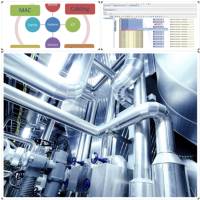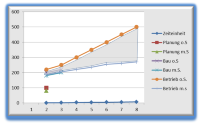The requirements
The requirements of the industry unite the requirements of the FM and technology management topics. Characterized by high dynamics, fast change processes, highest demands on availability and functionality, as well as various technologies in plants, buildings and production technology, all information should be transparent for management and operation. There is information which is documented, others which is imported or comes from control and element information systems of the plants. Networks, from signalling technology to IT and supply, are the nerve systems of the sites. In addition, there are many legal framework conditions and regulations that must be adhered to. All this information does not belong in hundreds of tables, sketches or plans that have nothing to do with each other. They belong in a central database system from which all information can be correlated in a timely manner and queried user-specifically.
Our Solution: VIS//ON Industry Edition
The VIS//ON OSS solution for industry unites all disciplines for the efficient planning, operation and management of buildings, properties, technical facilities and networks on a central platform. All modules can be combined as required. The customers are therefore industry, commerce, the private sector and all those who have high demands on availability and cost-effectiveness.
VIS//ON accompanies the entire process from planning, installation, operation and reconfiguration of the locations, computer/distribution centres, technical installations, cable connections, areas, configurations, supply systems with connection of various control technologies. VIS//ON also covers administrative actions such as accounting, trouble ticketing and benchmarking.
The leading solution VIS//ON is modular and customizable for all mentioned areas.
Clients
Our target customers are industrial companies from all industries such as automotive, chemicals, pharmaceuticals, mechanical engineering and plant construction. Especially for companies that have several locations and branches, a standardization of documentation, technical plant management and processes is indispensable. The obligation to document and provide evidence to the authorities is also important and is playing an increasingly important role. Networked systems require networked data and systems.
Economic Efficiency
A holistic way of thinking from material purchasing to inventory management, pricing, quotation management, bookkeeping and sales is a matter of course in the commercial area of a company. In technical asset management, individual solutions still dominate, here a plan in Tool X, there one in Tool Y, Excel lists and paper documents. In reality, all this information is only one thing in common: it is never up-to-date. A central information platform therefore offers considerable potential for savings. Maintenance, service, process support and rule-based access by subcontractors to the data relevant to them also optimize deployment.
Data
Data are the raw materials of the information age. With VIS//ON the data is imported, entered or generated from the plants and correlated and processed in our system. At the push of a button, all information is available, together with plans and supplementary documents. All stakeholders are granted the appropriate access rights and can then retrieve the approved data themselves. The provision of data can, of course, also be handled as before. It is also possible to enter precise information from the project on site, together with status photos, via app.
USPs
- modularly adaptable to demand and company size
- rapid implementation
- communication also with mobile systems
- import functionality
- coupling with GIS/CAD and other enterprise systems such as CRM or ERP
- expandable at any time
- can also be used as a SaaS solution for smaller customers
- several million properties with customers
- several thousand locations
- multilingual
- supports all phases from planning through installation to operation.
- integration of mobile devices
- connection to control systems, import of data, input of data
- role-based integration of all stakeholders
IOT/ Industry of Things/ Industry 4.0
If you look at the current technical developments in most areas: Digitalization, central management of different resources, integration of specialized external companies, intelligent systems in ALL areas, networked systems, traffic systems and services, then it is sometimes surprising which methods and means are used to keep the overview; regardless of the legal framework conditions.
The first step, the right priorities and a plan for implementation are decisive for success.




